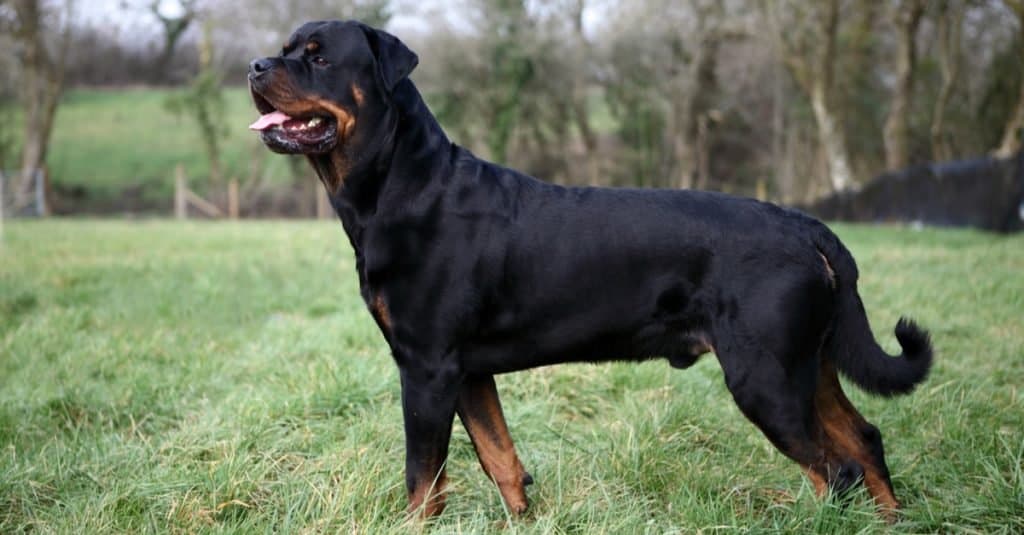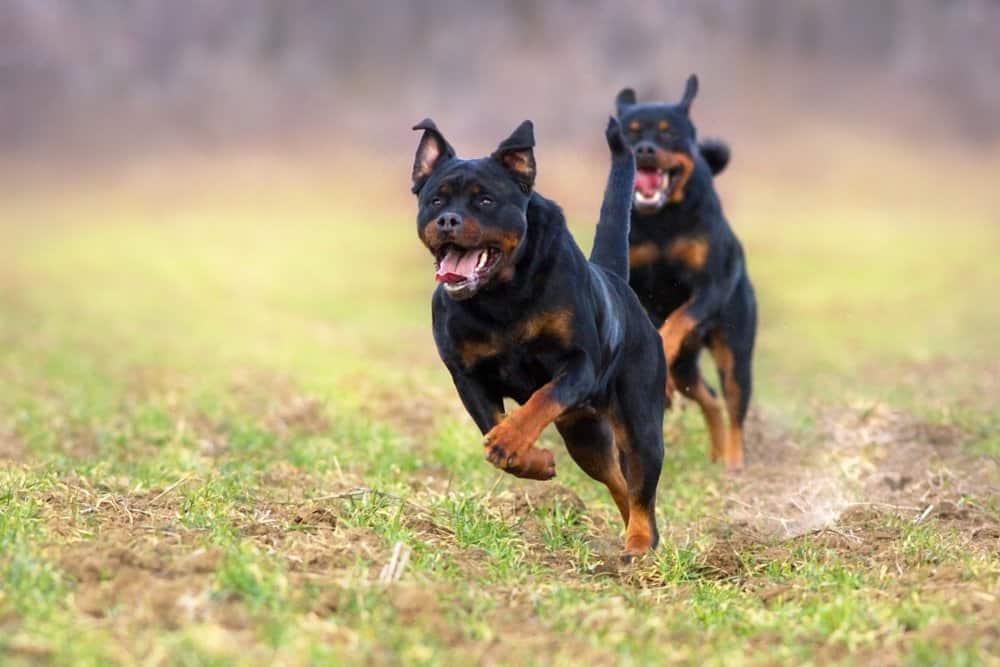Which is the better Rottweiler line: the Serbian or German rottweiler?
In this case, there’s little competition. Serbian Rottweilers are larger and bred with many disproportionate features that negatively impact their health, while German Rottweilers have stricter breed standards and are generally much healthier.
If you plan to rescue a Rottweiler, this article can still help you to prepare—whether you want to give a chance to a poorly-bred rescue Rottie or adopt the healthiest dog possible.
Keep reading to learn more about the Rottweiler breed and the Serbian and German lines!
Comparing Serbian Rottweiler vs German Rottweiler

| Serbian Rottweiler | German Rottweiler | |
|---|---|---|
| Size | Large with stocky build and block head | Generally smaller and less stocky |
| Appearance | Large head, brachycephalic, sloped back, stocky build | Less stocky, longer snout, straight back |
| Standards | Loose | Strict |
| Health | Generally of poorer health | Generally healthier |
| Country of Origin | Germany | Germany |
Key Differences Between Serbian Rottweiler and German Rottweiler
The main difference between Serbian and German Rottweilers is health, and poor breeding in Serbian lines has led to many additional health problems for the poor pups.
Other key differences include size, appearance, and breeding standards.
Let’s delve into these differences below to learn more about these different types of rottweiler!

Serbian and German Rottweilers are the same breed but tend to be bred differently and vary in health.
©Rita_Kochmarjova/Shutterstock.com
Serbian Rottweiler vs German Rottweiler: Size
Generally, Serbian Rottweilers are bred for size and will be larger than German Rotties. However, this isn’t guaranteed since Serbian Rotts don’t follow a strict breed standard.
You can expect Serbian Rottweilers to fall on the highest end of the spectrum when it comes to weight, maxing out at 159 pounds.
German Rottweilers tend to follow stricter breeding standards. Females stand 22-25 inches (56-62 cm) tall and weigh around (42 kg). Males stand 24-27 inches (61-69 cm) tall and weigh about 110 pounds (50 kg).
Some males may weigh up to around 130 pounds or 59 kg.

Serbian Rottweilers may have wrinkles in the face, requiring extra grooming to maintain skin health.
©McCann Michelle/Shutterstock.com
Serbian Rottweiler vs German Rottweiler: Appearance
German Rotties have a more defined appearance due to following stricter guidelines. According to the ADRK, the dogs should be proportionate and strong, and “the foreface should appear neither elongated nor shortened in relation to the cranial region.”
Serbian Rottweilers are typically broader in appearance. They’re bred to be stocky and frequently poorly bred to have disproportionate features.
These include a sloped back, facial wrinkles, and a brachycephalic (short) snout.

Serbian Rottweilers tend not to be bred for health, while German Rottweilers have high breed standards.
©Miroslav Cik/Shutterstock.com
Serbian Rottweiler vs German Rottweiler: Breeding Standards
Serbian Rottweilers generally have poor breeding standards and don’t adhere to them as strictly. There is more variety in appearance, temperament, and health.
German Rottweiler lines tend to follow stricter breeding standards, leading to healthier dogs and a more uniform appearance and temperament.
If you’re looking to adopt from a breeder, we recommend ensuring you’re purchasing from someone reputable—no matter which Rottweiler lines they breed.
Finding a Reputable Breeder
- Visit the dogs’ home and see the mom and puppies. This ensures that the dogs are well-kept. You’ll also notice if the mom or pups are visibly unhealthy.
- Obtain proof of veterinary paperwork and health checks for the parents and puppy. Reputable breeders ensure they’re breeding the healthiest dogs possible and don’t mind showing you the records to prove it!
- Ask questions about the breed and puppies. Walk away if the breeder lies, such as saying Rottweilers don’t have any genetic health problems or behavioral concerns.
- Never buy a short-muzzled or sloped-back puppy. This includes if one of the parents has one of these conditions. We’ll talk more about the health problems that occur from these below.
- Reputable breeders will also have questions for you. If it’s super easy to adopt a puppy, chances are you aren’t purchasing from someone reputable. Reputable breeders have waitlists, ask questions about your home and family, and don’t give puppies to just anyone!
Never meet in a neutral location, purchase from a pet store, or order a dog online without visiting the home.
If your breeder refuses to answer questions, show veterinary paperwork, or shows other red flags, be ready to walk away.
It can be tempting to “rescue” a puppy from a breeder, but this actually causes more damage. If breeders cannot sell puppies, they typically end up in a shelter or with a rescue, leading to them finding homes without the breeder profiting.
If someone buys from the breeder in an attempt to save the puppies from poor conditions, this, unfortunately, funds further abuse and will allow them to continue breeding and profiting.

A Serbian Rottweiler’s sloped back and short snout can cause health concerns, including joint problems and difficulty breathing.
©Callipso/Shutterstock.com
Serbian Rottweiler vs German Rottweiler: Health
Any Rottweiler can have health problems, just like any dog! There’s no way to ensure complete health. However, when adopting from a breeder, it’s vital to adopt from someone who health tests the parent dogs.
It’s also important not to adopt dogs bred to be unhealthy, which Serbian lines often are. Quality breeding is the number one way to lengthen a puppy’s lifespan.
All Rottweilers are predisposed to the following, though some conditions can be avoided through reputable breeding:
- Hip and elbow dysplasia: Large dogs are prone to hip and elbow dysplasia, though a reputable breeder will screen for these conditions.
- Arthritis: Most dogs develop arthritis by 8 years old. Large dogs and Rottweilers, in particular, are more predisposed than smaller breeds.
- Juvenile Laryngeal Paralysis & Polyneuropathy (JLPP): This condition is handed down by both parent dogs and is screened for by reputable breeders. It’s only seen in a handful of breeds, Rotts included.
- Heart problems
Serbian Rottweiler Health
Serbian lines, in particular, may see health concerns due to inbreeding. They also frequently have sloped backs, leading to an irregular gait (or the dog not walking as usual) and worsened joint problems, particularly late in life. This is especially bad because Rotties are already large dogs, predisposing them to joint issues and arthritis.
Serbian Rotts are also often brachycephalic. This means they’re bred to have short snouts, leading to breathing difficulties, exercise intolerance, eye conditions, teeth problems, and more.
Brachycephalic breeds are also more prone to heat stroke than longer-snouted dogs. Combined with the large size and dark fur of Rottweilers, they may be very heat intolerant.
Rottweilers are very energetic dogs that require plenty of daily exercises. Sadly, however, brachycephalic snouts can make this difficult. They may suffer breathing difficulties or heat stroke during strenuous exercise or in the heat.
To put it plainly, these poorly-bred pups will struggle to live their lives daily and follow the instincts that were originally bred into them.
Serbian Rottweiler vs German Rottweiler: Country of Origin
It’s easy to think that Serbian Rottweilers must originate from Serbia and German Rottweilers from Germany. However, it’s not quite so simple.
When we trace the Rottweiler breed back, all of these pups have German roots. So, what’s the difference between these dogs?
It’s not their origin or their birthplace. Instead, it has to do with lineage.
German Rottweilers tend to have a better pedigree and healthier ancestry. Reputable German breeders follow strict breed guidelines as set by the ADRK.
Serbian Rottweilers have ancestry brought to Serbia and often, though not always, poorly bred.
There are also American and other European lines. Often, American breeders will seek German Rottweilers to better the health of their lines, and American people may seek to adopt puppies from German lines.
However, these dogs don’t become American Rottweilers by being brought into the United States! This is because they still have German lineage going back generations.
The photo featured at the top of this post is © iStock.com/BiancaGrueneberg
Ready to discover the top 10 cutest dog breeds in the entire world?
How about the fastest dogs, the largest dogs and those that are -- quite frankly -- just the kindest dogs on the planet? Each day, AZ Animals sends out lists just like this to our thousands of email subscribers. And the best part? It's FREE. Join today by entering your email below.
Thank you for reading! Have some feedback for us? Contact the AZ Animals editorial team.






